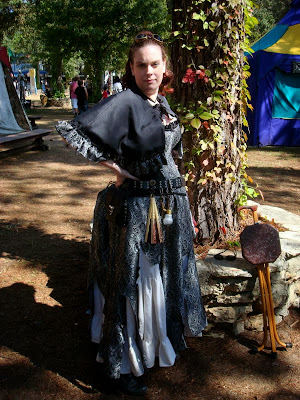 |
| The original outfit, last March. |
And I had gotten bored with my black and silver outfit. This is almost my oldest steampunk outfit, the oldest that I still wear in some form. I've talked before about how the outfit has transitioned over time. But ever since I "finished" it I've been kinda bored with it. I don't wear it much. It's kinda a winter outfit and I don't do much costuming in cold weather (cause there isn't much cold weather to find around here.)
 |
| The Petticoat, pre-destuction. Notice Dremel and Nerf gun on the floor, proving I'm a steampunk. |
So then I put the new petticoat over my bustle pad onto a dress form. And then the patterned skirt over it. And I looked at it for several days thinking about how I wanted to destroy it. My cats developed a love for sitting under the skirt and were really pleased when I didn't stop them from clawing it. Probably wasn't a wise move on my part to let them but I'm a pushover.
So finally I attacked the skirt with scissors. I wasn't sure how the poly brocade would behave once I tore it and how much I might need to burn to keep it from unraveling. But I didn't want the edges to look like burned polyester. I actually didn't end up burning much. Lots of threads came off the skirt as I tore and frayed, but it eventually reached a point it
 |
| Skirt pre-damage, with Weasel the cat chilling underneath. |
At first I thought I would just make some ragged slits in it, to show the petticoat underneath, but decided it needed to be more drastic to really "read" as a disaster victim outfit. So I cut one large section away from the skirt, with several slits around the front half. In the back I had less damage, but cut the ends raggedly.
The petticoat I cut less, making two large slits on the side-fronts under the slits on the overskirt. I had considered tearing off parts of the ruffle, but couldn't really see how that would improve the look. I wanted to add dirt to the white petticoat around the bottom, but I suddenly ran out of time and needed it for the next day. So I coffee-dyed the bottom of the skirt. It's a subtle dye and I hoped it would have been more uneven, but it spread into an even color that continues quite a ways up the skirt.
Then I took it outside and burned it. The cotton actually burned and I let it get brown spots before smothering the flames. I burned holes in places and just burned the ragged edges in others.
For the rest of the outfit, I had less set plans. I didn't want to do too much damage to the corset, and it was starting to look worn anyway. I did add some ruffle trim to the top of the bust to help keep me from flashing everyone. The bust has never really fitted me right in this corset. Actually, it's fairly amazing how poorly fitted this corset is compared to the corsets I'm making now, two years later.
I made myself a capelet (using this pattern) to wear over the top. I've never been totally happy with the jacket of this outfit, and it suffered a laundry mishap that removed all the lettering from the back. So it was easier to whip up a capelet. I basted on the ruffle of the pattern fabric, using fabric I'd cut from the skirt when ripping it. I left the edge unfinished and pulled it to tatter it, and burned it away in places. Unfortunately, I don't think that really comes across very well.
And that's that. I wore this modified outfit on Saturday to the Texas Renaissance Festival for their Halloween weekend. I didn't draw much attention, although I think that's partly how ungodly crowded it was. I really only had one conversation about the state of my outfit, and I'm not entirely sure if the woman understood it was intentional damage, even when I repeatedly said it was due to my airship crashing. (I had considered telling people my cats did it all, but I'm afraid people would think I was serious.)
 I don't think it reads exactly like I intended. As much tearing as I did, I think the cape needs to be torn, (although I wanted to remove the trim and reuse it at a later point) and I probably need some messy and bleeding make-up. (I'm so bad at even normal make-up that I really am afraid to try for "effects".)
I don't think it reads exactly like I intended. As much tearing as I did, I think the cape needs to be torn, (although I wanted to remove the trim and reuse it at a later point) and I probably need some messy and bleeding make-up. (I'm so bad at even normal make-up that I really am afraid to try for "effects".) So I guess I learned that if you want an extreme effect you need to go really "big" with your costuming. On the other hand, I don't think this was the perfect environment for this costume. At a steampunk con it would draw a lot more attention in contrast to people's more put-together costumes than at a Renaissance Faire where there is such a variety of costumes. Anyway, I may work some more on this and try again some time, but it was a fun experiment.

























